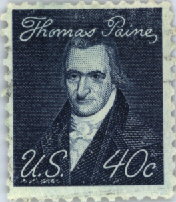The Political pamphlet: Thomas Paine (1737-1809)
 The passion of Revolutionary
literature is found in
pamphlets, the most popular form of political literature of the
day. Over 2,000 pamphlets were published during the Revolution.
The pamphlets thrilled patriots and threatened loyalists; they
filled the role of drama, as they were often read aloud in public
to excite audiences. American soldiers read them aloud in their
camps; British Loyalists threw them into public bonfires.
The passion of Revolutionary
literature is found in
pamphlets, the most popular form of political literature of the
day. Over 2,000 pamphlets were published during the Revolution.
The pamphlets thrilled patriots and threatened loyalists; they
filled the role of drama, as they were often read aloud in public
to excite audiences. American soldiers read them aloud in their
camps; British Loyalists threw them into public bonfires.
Thomas Paine's pamphlet Common Sense sold over 100,000 copies in the first three months of its publication. It is still rousing today. "The cause of America is in a great measure the cause of all mankind," Paine wrote, voicing the idea of American exceptionalism still strong in the United States -- that in some fundamental sense, since America is a democratic experiment and a country theoretically open to all immigrants, the fate of America foreshadows the fate of humanity at large.
Political writings in a democracy had to be clear to appeal to the voters. And to have informed voters, universal education was promoted by many of the founding fathers. One indication of the vigorous, if simple, literary life was the proliferation of newspapers. More newspapers were read in America during the Revolution than anywhere else in the world. Immigration also mandated a simple style. Clarity was vital to a newcomer, for whom English might be a second language. Thomas Jefferson's original draft of the Declaration of Independence is clear and logical, but his committee's modifications made it even simpler. The Federalist Papers, written in support of the Constitution, are also lucid, logical arguments, suitable for debate in a democratic nation.
